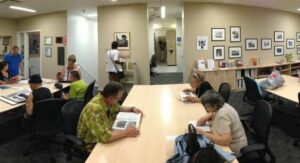Puerto Rican New Yorkers: Workers, Unions and Politics in the Struggle for a Better Life, 1910s-1960s
Aldo A. Lauria Santiago

The narratives, documents, and arguments presented in these blogs are based on my research for various books. When I began to research the history of Puerto Ricans in New York as workers (and New Yorkers), I knew that a traditional labor history approach that limited itself to unions or labor leaders would be an important component, but would not suffice. I had to research their lives as workers follow them home and examine some of the “connective tissue” that defined working-class Puerto Ricans’ community and neighborhood lives. When I started this project, I did not yet understand how rich and complex the stories and sources I encountered would become, calling for different skills and approaches. As I proceeded, I had to engage with questions drawn from race, urban, cultural, social, economic, political, and migration history. I also learned how many pieces of the history of our communities remained poorly understood, even after hundreds of research reports, theses, and other pieces of work had accumulated over the years.
The years covered in the blogs range from the 1900s to the early 1970s, and the themes emphasize stories of work, working-class people, and their struggles. The larger contexts of liberalism and radicalism were encountered and embraced by Puerto Ricans in New York. The research in these blogs was carried out in dozens of archives and libraries (and is still incomplete). Still, the valuable materials held at Centro library and archive were imprescindibles.
Puerto Ricans who migrated to New York joined one of the largest concentrations of urban wage workers in the world. Most migrants were already familiar with the routines and conditions of wage work while others had to adjust to the challenges of a highly developed industrial city where both exploitation as well as opportunities for better wages abounded. Puerto Ricans engaged precociously with the rich spaces they found or created new ones to meet their needs. Work, leisure, family life, and politics consumed most of their energies. Still, in New York, the complexity of urban, class, racial, and ethnic contexts could be daunting and require a myriad of adjustments. The city offered opportunities for solidarity and new forms of organization and improvement, as well as unpredictable risks and new problems.
Puerto Ricans developed many strategies and responses to these challenges. Among these was concentrating (by lack of options or by choice) in buildings, blocks, and neighborhoods and, from there, meeting life’s challenges in New York. But the adjustment and response also included less centripetal relations, including the far-flung alliances that labor, liberal, and socialist politics facilitated and encouraged, as well as the struggles that emerged from forming part of a working class in which ethnicity, race, color, national origin, language, and ideologies drew a maze of possibilities.
These blogs will introduce many of the rich contexts in which Puerto Rican New Yorkers engaged with larger movements and struggles from the 1910s to the 1970s. The mosaic represented here includes only some of the stories. The blogs and documents refer to various themes, including cigar makers, Communist Party networks, garment unions, fights against exploitation, and insights into the myriad interactions between Puerto Ricans, migrants, and second generation in New York’s then-vast industrial, union, and liberal-state landscape. The blogs are written for a general audience and try to avoid the arguments and language of the academic monograph. They are also a work in progress, so you might see updates and additions. The blogs are not intended to provide complete coverage but to suggest the issues, voices, and stories of a small set of the places and contexts experienced by Puerto Ricans in New York.
I hope that these stories and the books associated with this research (including the volume co-authored by Lorrin Thomas–Rethinking the Struggle for Puerto Rican Rights-Routledge Press) will serve as a tribute to the fights, small and large, successful and not-so-successful, of so many Puerto Ricans to earn a decent living with dignity, together with many other New Yorkers.
I am grateful for the support for this project from the Rutgers School of Arts and Sciences, former Director of the Center for Puerto Rican Studies, Director Edwin Melendez, Centro archive staff, and dozens of archivists and librarians from a long list of collections. Gabrielle DaCosta and Natalie Saldarriaga helped edit the blogs. I also thank the many research assistants, especially Luz Sandoval, who have helped with the research over the years.
These blogs were initially published as part of the Center for Puerto Rican Studies online journal but were later unpublished.
Next: A Middle Class of Empire
Aldo Antonio Lauria Santiago
Professor of Caribbean, Latin American, and US Latino History
Rutgers University, New Brunswick
All material is copyrighted by the author, 2019, 2025.
Users may cite or quote with attribution.
Copyright for all linked texts: Aldo Lauria Santiago